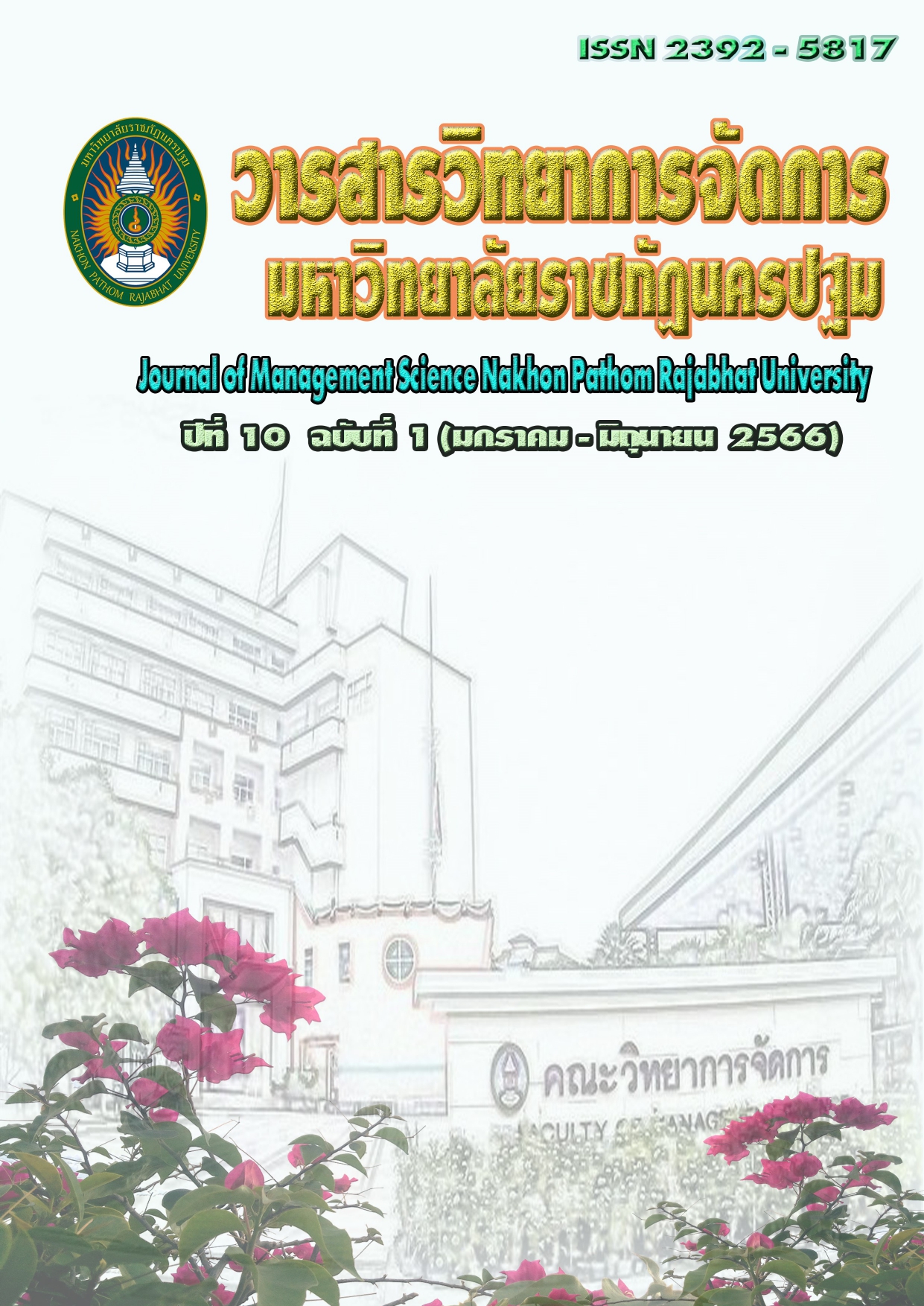ปัจจัยเชิงสาเหตุที่มีอิทธิพลต่อความสำเร็จของธุรกิจสปาเพื่อสุขภาพในประเทศไทย
Main Article Content
บทคัดย่อ
การวิจัยนี้มีวัตถุประสงค์ (1) เพื่อวิเคราะห์ปัจจัยที่มีอิทธิพลต่อความสำเร็จของธุรกิจสปาเพื่อสุขภาพในประเทศไทย (2) เพื่อตรวจสอบความสอดคล้องของรูปแบบความสัมพันธ์เชิงสาเหตุของปัจจัยที่มีอิทธิพลต่อความสำเร็จของธุรกิจสปาเพื่อสุขภาพในประเทศไทยกับข้อมูลเชิงประจักษ์ การวิจัยนี้เป็นการวิจัยแบบผสานวิธี การวิจัยเชิงปริมาณใช้วิธีเก็บรวบรวมข้อมูลด้วยแบบสอบถามจากผู้ประกอบการธุรกิจสปาเพื่อสุขภาพ ประชากรจำนวน 9,080 ราย กลุ่มตัวอย่างจำนวน 400 ราย และการวิจัยเชิงคุณภาพใช้วิธีการสัมภาษณ์เชิงลึกด้วยแบบสัมภาษณ์กึ่งโครงสร้างจากผู้ให้ข้อมูลสำคัญที่มีความเกี่ยวข้องกับการประกอบธุรกิจสปาเพื่อสุขภาพ จำนวน 15 คน สถิติที่ใช้ในการวิเคราะห์ข้อมูลได้แก่ ร้อยละ ค่าเฉลี่ย และส่วนเบี่ยงเบนมาตรฐาน การวิเคราะห์ข้อมูลเพื่อทดสอบสมมติฐานวิจัยใช้การวิเคราะห์สมการเชิงโครงสร้าง
ผลการวิจัยพบว่า (1) ปัจจัยเชิงสาเหตุที่มีอิทธิพลทางตรงต่อความสำเร็จของธุรกิจสปาเพื่อสุขภาพมากที่สุดคือการมุ่งเน้นการบริการ รองลงมาคือการมุ่งเน้นการตลาด และนวัตกรรมการบริการตามลำดับ โดยตัวแปรทั้งสามสามารถอธิบายความแปรปรวนของความสำเร็จของธุรกิจสปาเพื่อสุขภาพ (R2) ได้เท่ากับ 0.87 (87.0%) (2) รูปแบบความสัมพันธ์เชิงสาเหตุพบว่ารูปแบบความสัมพันธ์ตามกรอบแนวคิดการวิจัยมีความสอดคล้องกับข้อมูลเชิงประจักษ์ โดยมีค่าดัชนีความกลมกลืนของโมเดลดังนี้ X2=288.85, df=116, X2 / df = 1.973, p-value = 0.051, GFI = 0.955, AGFI = 0.953, CFI = 0.988, NFI = 0.976, TLI = 0.988, RMSEA = 0.049
*นักศึกษาหลักสูตรบริหารธุรกิจดุษฎีบัณฑิต มหาวิทยาลัยกรุงเทพธนบุรี 10170
ภายใต้การควบคุมของ รองศาสตราจารย์ ศิริพร สัจจานันท์ อาจารย์ ดร.สุพัตรา จันทนะศิริ และ อาจารย์ ดร. ฐนันวริน โฆษิตคณิน
Corresponding author: sarantorn_rcp@hotmail.com
Article Details

อนุญาตภายใต้เงื่อนไข Creative Commons Attribution-NonCommercial-NoDerivatives 4.0 International License.
ทัศนะและข้อคิดเห็นของบทความที่ปรากฏในวารสารฉบับนี้เป็นของผู้เขียนแต่ละท่าน ไม่ถือว่าเป็นทัศนะและความรับผิดชอบของกองบรรณาธิการ
เอกสารอ้างอิง
คณะกรรมการยุทธศาสตร์ชาติ. (2561). ยุทธศาสตร์ชาติ พ.ศ. 2561- 2580. กรุงเทพฯ : สำนักงานคณะกรรมการพัฒนาเศรษฐกิจและสังคมแห่งชาติ.
พหล ศักดิ์คะทัศน์ และอิทธิฤทธิ์ พลังธีรสิน. (2553). การพัฒนาดัชนีชี้วัดและปัจจัยที่มีผลต่อความสำเร็จอย่างยั่งยืนของธุรกิจสปา และนวดแผนไทยโดยชุมชนในจังหวัดเชียงใหม่. การประชุมวิชาการของมหาวิทยาลัยเกษตรศาสตร์ ครั้งที่ 48, สาขาเศรษฐศาสตร์และบริหารธุรกิจ.
พิบูล ทีปะปาล และธนวัฒน์ ทีปะปาล. (2559). การจัดการเชิงกลยุทธ์. กรุงเทพฯ : อมรการพิมพ์.
ภักดี กลั่นภักดี อัศวิน แสงพิกุล และศิริเดช คำสุพรหม. (2563). การพัฒนาธุรกิจสถานประกอบการ สปาเพื่อสุขภาพระดับสากลในประเทศไทยสู่ความยั่งยืน. วารสารวิชาการสาธารณสุข, 29(6), 1147-1156.
ศูนย์เทคโนโลยีอิเล็กทรอนิกส์และคอมพิวเตอร์แห่งชาติ. (2555). งานวิจัยนโยบายประเทศไทย. [ออนไลน์].ค้นเมื่อ 11 สิงหาคม 2564 จาก https://www.nectec.or.th/nectec/policy-th.html
สมร ดีสมเลิศ. (2554). รูปแบบปัจจัยการมุ่งเน้นการตลาด ปัจจัยการมุ่งเน้นการบริการ ปัจจัยด้านองค์กร และปัจจัยนวัตกรรมการบริการ ที่ส่งผลต่อผลประกอบการของธุรกิจสปาเพื่อสุขภาพในประเทศไทย. ดุษฎีนิพนธ์บริหารธุรกิจดุษฎีบัณฑิต มหาวิทยาลัยอีสเทิร์นเอเชีย.
สุฐะภร จันทรา และวุฒิไกร งามศิริจิตต. (2563). การศึกษาปัจจัยความสำเร็จของธุรกิจงานบริการท่องเที่ยวเชิงสุขภาพ กรณีศึกษากลุ่มธุรกิจสปาเพื่อสุขภาพ. วารสารการบริการและการท่องเที่ยวไทย, 15(1), 58-71.
อัครพงศ์ อันทอง และ มิ่งสรรพ์ ขาวสอาด. (2557). การเปรียบเทียบสมรรถนะและประสิทธิภาพ การดำเนินงานของธุรกิจสปา. วารสารเศรษฐศาสตร์ประยุกต์, 21(1), 1-19.
Abker, A., Mohammed, M., Tebein, A. and Gafar, M. (2019). Strategic Orientation and its Impact on the Improvement of Service Innovation. International Journal of Economics, Business and Management Research, 3(7), 67-81.
Berry, J.W., Phinney, J.S., Sam, D.L., and Vedder, P. (2006). Immigrant youth in cultural transition: Acculturation, identity and adaptation across national contexts. Mahwah, NJ: Lawrence Erlbaum Associates.
Global Spa Summit. (2011). Wellness tourism and medical tourism: Where do spas fit?. Retrieved April 11, 2021 from http://www.globalspaandwellnesssummit.org/
images/stories/pdf/spas wellness medical_tourism_report_final.pdf
Hair, J.F., Black, W.C., Babin, B.J. and Anderson, R.E. (2010). Multivariate Data Analysis.
(7th ed). New York: Pearson.
Jiménez‐Zarco, A.I., Pilar Martínez‐Ruiz, M. and Izquierdo‐Yusta, A. (2011). The impact of market orientation dimensions on client cooperation in the development of new service innovations. European Journal of Marketing, 45 (1/2), 43-67.
Jaworski, B. J., and Kohli, A. K. (1993). Market orientation: Antecedents and consequences. Journal of Marketing, 57(3), 53–70.
Norasucha.V. (2007). Value chain management model for performance. (Unpublished master's thesis). Shinawatra University, Phathumthani.
Porter, M. E. (2006). The Competitive Advantage of Nation. Retrieved April 11, 2021 from http://www.geocities.com/allava_2009/strategy.html
Udriyah, U., Tham, J and Azam, S. (2019). The effects of market orientation and innovation on competitive advantage and business performance of textile SMEs. Management Science Letters, 9(9), 1419-1428.

